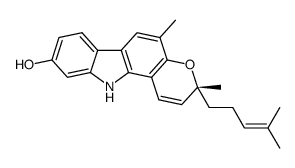28360-49-8
| Name | mahanine |
|---|
| Description | Mahanine is a carbazole alkaloid with various biological properties. Mahanine is a potent anticancer agent against different types of cancer cells. Mahanine exhibits antileishmanial activity and can be used for Leishmania infection treatment research[1]. |
|---|---|
| Related Catalog | |
| In Vitro | Mahanine (0-50 µM; 24 or 48 hours) induces a dose-dependent decrease in cell viability of AG83 promastigotes after 24 hr and 48 hr; the IC50 values were 16.7±1.7 µM and 11.5±0.8 µM respectively. In a drug resistant GE1 strain, Mahanine treatment exhibits dose-dependent cell death in 24 and 48 hr treatment with IC50 values 40.3±2.2 µM and 29.1±1.3 µM respectively[1]. Mahanine (5.0 and 10 µM; 24 hours) exhibits increased accumulation of cells at G2/M phase being 39.0±1.90% and 41.0±2.10% respectively compared to untreated promastigotes (35.3 ± 2.60%) in AG83 promastigote [1]. Mahanine (25 µM; 24 hours) exhibitssignificantly increased intracellular ROS level within 20 min (MFI being 889 ± 26) which reached to 1288 ± 56 after one hour compared to the basal level (604 ± 34) in untreated promastigote. H2DCFDA positivity was measured by FACS[1]. |
| In Vivo | Mahanine (oral gavage; 20 mg/kg/40 mg/kg; b.w/day; 5 days) results in 89.1±4.1% reductions in parasite burden at 20 mg/kg, and leads to 96.2±0.3% reductions in parasite burden at 40 mg/kg in a well-established acute model to control Leishmania infection[1]. Animal Model: Balb/c mice with virulent AG83 promastigotes[1] Dosage: 20 mg/kg-40 mg/kg Administration: oral gavage; 20 mg/kg/40 mg/kg; b.w/day; 5 days Result: Had the potential to clear parasite burden in vivo. Exhibited almost complete reduction of parasite burden, upregulation of NO/iNOS/ROS/IL-12 and T cell proliferation in vivo. |
| References |
| Molecular Formula | C23H25NO2 |
|---|---|
| Molecular Weight | 347.45000 |
| Exact Mass | 347.18900 |
| PSA | 45.25000 |
| LogP | 6.24580 |
| Hazard Codes | Xi |
|---|
